Living here in the Sunshine State, it seems that folks have an unusual penchant for $0.69 sq. ft. 20″ tiles. The most popular colors are blah, boring, and blech. People love to toss these tiles down over red oak, irreplaceable heart pine, and any number of historic floors.
These tiles are spreading like a wildfire across the floors of historic homes. Something must be done! Which brings us to our number 2 worst mistake of historic homeowners…
Flooring
Historic houses are having their floors covered up, ripped out, or trashed in any number of ways to make room for newer, inferior products. Only in America would we be ignorant enough to cover what would be a $15 or $20 per sq. ft. floor with a $.50 per sq. ft. floor. Are we really that shallow? Historic homes have some of the finest flooring available. Have you ever seen a 70 year old vinyl floor? I didn’t think so. How about laminate flooring that has made it even 30 years? Me neither.
Todays floors, even the top quality ones, come with 25 and even 40 year warranties which isn’t too bad, but why would you replace a floor that will last centuries with one that lasts only a third that long?
And in today’s real estate market, most of us are being ever mindful of home values. The typical buyer of an old or historic home is expecting hardwood floors. “Maintenance-free” tile is not a selling point for these kind of houses. And while a click-lock engineered wood or laminate floor may be considered an upgrade on a new home, it is a definite cold shower to your historic home’s market price. The jura hausarbeit ghostwriter shared one fact with me. Some homeowners, when selling a historic home, enter into a legal contract where they describe that the floor cannot be replaced because it is historic property.
Wood Floor Restoration
Wood floors are prime candidates for refinishing and restoration. If you have pet stains, loose/missing boards, rot, termite damage, or other issues, these are simple repairs for a flooring professional. And if you get someone who says your floors aren’t repairable, they are most likely either too lazy to do the work or trying to sell you new floors. Either way, RUN! I have yet to come across a solid wood floor that couldn’t be repaired. The same is almost never true for tile, laminate, vinyl or even engineered wood floors.
Probably one of my favorite jobs restoring a floor was this 1920s heart pine I came across. The home had been used as a business for a time and apparently there had been some damage to the original floors that was patched…well, let’s just say poorly, and then carpeted over. When the new homeowner found the damage she intended to tile over the entire house with the afore mentioned tile.
I was referred to her when her tiling was about halfway done and convinced her (read: begged) her to save the remaining floors because they were not beyond repair. A week later after replacement boards were installed and the floors were refinished, she had what looked like new floors!
Solid wood flooring, like this, found in most historic homes is extremely resilient. It can handle multiple refinishings (done properly) over its life and is easy to repair in a way that is almost certainly unnoticeable. And what’s best is that it can last hundreds of years with minimal care!
So, before you jump to “upgrade” the flooring in your historic home, take a minute and think it over. Do you want a different color? Stain it. A different glossiness? Refinish it. You can even paint your wood floor to look like almost anything. The only boundaries are your own imagination. And if you are wondering if your floor can be repaired, the answer is almost always “Yes!” Search around for a hardwood refinishing specialist or restoration company and you will find someone up to the task of rejuvenating your floors. And trust me, it will be worth it!
Tired of the same old wood floors? You can make quite a statement with some stain or paint. I’ve included some fun ideas of what others have done with their hardwood floors. Get creative!
You can also learn more about the history of hardwood floors in our post A History of Wood Floors
Read the rest of the 5 Worst Mistakes of Historic Homeowners:

Founder & Editor-in-Chief
I love old houses, working with my hands, and teaching others the excitment of doing it yourself! Everything is teachable if you only give it the chance.

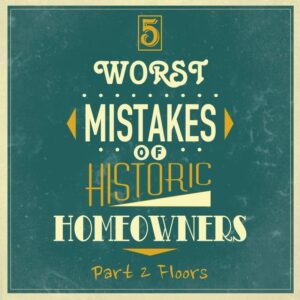
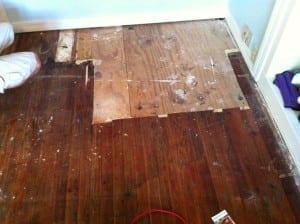
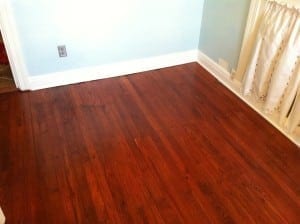
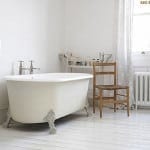


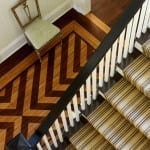
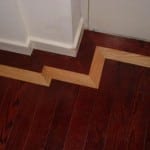
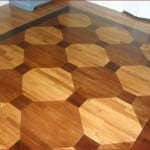


Hi, I have a home built in 1923 with original stained oak trim, coffered ceilings etc.
I have to replace my oak flooring and was wondering – I was going to replace it with 3 1/4 inch planks. Should I use red oak again, or can I use white (or red) quarter sawn oak.
I’m having a hard time trying to figure out what would look best (I know 3 1/4 planks of red oak will look much more grainy then the 2 1/4 strips that were originally there, so maybe go quarter sawn instead?).
Many thanks
Connie, if you can afford it quartersawn wood is always a better choice. It’s more stable and will wear better on floors. Is there a reason you don’t want to go with the standard 2 1/4″ boards?
Hi, I wanted to have a slightly “updated” home. We’re keeping all the original trim, but installing a modern kitchen and I thought that slightly wider floor (3 1/4) would be a nice update.
I just wasn’t sure if the white quartersawn would look good with all the red oak trim – does it need to match??
thanks
Nice write up. I for one think that way to many people just don’t realize the long term value of a hard wood floor.
When I go out and a carpeted floor is in to bad of shape to clean I always look under it. So often homeowners are surprised to find a high quality hardwood floor that’s been buried under carpet for the last 50 years.
I have a deal with a local flooring guy. After showing the home owner some of his brochures and getting them interested. If he gets the refinishing job, I get a small kickback, he gets another refinishing job to add to his portfolio, and the both of us get a customer and friend for life.
Everybody wins, and another antique wood floor is brought back where it can be enjoyed again.
I need to install whole new floor in a old wooden house. the prior owner removed all floor the current area has no floor at all. How should mach up the remaining floors/
Thanks for great sharing. I’m your fan. I read and learn a lot useful information in your website and apply it for my home improvement.
Hi we just bought a house built in 1890. I ripped up the 70s shaggy carpet in the entry way and staircase and hallway the plank flooring underneath appears to be in decent condition but is very dry feeling. What should we use to restore it?
Anna, a light sanding and add a stain and polyurethane or you could do a boiled linseed finish for a more natural feel.
I’m glad to have found this article as I met with a contractor yesterday about my kitchen floor. I have a 1910 colonial and have been trying to slowly getting the floors back.I was told that because there is a sub floor under the linoleum with another layer of linoleum under that before getting to the wood, there would be too much damage to save the floor.I am disappointed -Has anyone experienced this? What should I do?
You can’t tell if there is too much damage until you really get into the floor. Most contractors don’t won’t to bother with the work to restore the wood floors. It is likely restorable it just depends on the cost of the work you’re willing to pay.
12 yrs ago we renovated kitchen in our 1911 home; our flooring sub burned up several sanding belts working through about 4 generations of varying linoleum, but FINALLY uncovered the original subfloor, gorgeous red heart pine. Sanded, stained and polyurethaned — it is gorgeous and was WELL WORTH the effort!
I have a 10-14 year old house. this has a ground floor is with regular termite treatment. I am planning to build 2 new floors on this. how safe it would be? what test should I get done before building new floors, so to ensure that the ground floor will hold it proper and safe?
Get a structural engineer to sign off on the plans before starting any work.
I have a Craftsman home built in 1919 I am renovating. I removed the vinyl tile from the kitchen and went back to the wood flooring underneath. The bath has vinyl on top and looks like wood underneath too. What kind of flooring did they have back then in the bath? I know you’re not really supposed to have wood floors in the bath but wondered what your thoughts are on it.
Diana, bathroom floors in 1919 were usually either wood or small mosaic tile. You could stick with the wood if you like it.
I have a 100 yrs craftsman -ish home with what looks like original flooring. There is no floor boards and some gaps in which you can see through the floor. What is the best way to restore or repair the floor?
Also wanted to add, there are gaps in the floor & dings in some spots, also squeaks & can see thru some gaps to the basement.
We have a house built in 1950. Our hardwood floors are 2 1/2 inch wide planks but are only 15 to 18 inches long and are in groups of 5. Between each group is a gap. There are no gaps between the individual planks in each group. It almost appears that the floors were picked up and moved here from another location in pieces. These are oak floors. Any explanation would be appreciated.
Mary, they may be parquet wood floors.
I recently discovered that my house has hexagon tiles in the bathroom underneath new tiles and the tile adhesive. Is there a way for me to remove the tile adhesive so I can get to those hexagon tiles? I would love to have the original floor in the bathroom.
I have done that a couple times with good results. You’ll need a floor scraper and a lot of adhesive remover. Keep the area well ventilated because the remover can create harsh fumes. Use some rough scouring pads to get the small residue at the end and it can come out quite nice. It’s a lot of work though!
I’m restoring lizzy borden’s kitchen and sitting room with the same floors. can you tell me if they were wood or some kind of lanoiliam I have them stripped to the floor boards. looks like they were wood. and I’m about to refinish them but I need to know. want it a historic as possible with the owner. thanks Richard.
We just purchased a 1910 craftsman with douglas fir flooring throughout. The problem is a previous owner hammered flat head nails all over ~ presumably to stop squeaking. Our flooring contractor said we need to stain almost black to cover the nail holes. Do you think there’s any way to have a more natural color on the floors. I would love to see the grain of the wood more than an almost black floor.
Your contractor is right that a darker color will hide the nail holes best. That being said, if you don’t mind the sight of the nail holes you could go with a slightly lighter color and have visible nail holes. Which is less attractive to you?
Cindy, another idea would be to take all these nail holes and fill them with real wood spools of the same variety of wood (or darker) and then sand them off. This will give the floor a hand pegged look, much more rustic, but would have a lot of character and allow you to enjoy the lighter stain and grain of the wood
Our wood floors have boards that are 2″ wide, cupped, worn with spaces in between that collects dirt. Is there any way to save them?
Finding this blog has renewed my hope in restoring the cherry wood floors in the bathroom of my 1846 Greek Revival Farmhouse in NW PA. Due to poor plumbing, the floor has suffered damage and the contractor cut a perfect square out around the toilet with the hopes I would just go with tile, and eventually tear all the wood flooring out. I would love to have the floor patched, in this area, with the same flooring to maintain the historic integrity of our home. Is it possible to patch within this area? Will boards need to be taken up and staggered to look right?
The floor can be repaired by weaving in new boards. Hopefully you can find replacement boards that look similar to the originals. If necessary you can pull boards from the backs of closets and use those to replace the damaged section.
I am so happy to have run across your blog.
Despite the well meaning advice of the contractor tempting me to sway away from restoration of the wood floor in my bathroom, it is now done and beautiful. I feel that we are conscientious of the water issues in a bathroom and will care for them accordingly. Thank you
Hey guys thanks for posting all of this information. I have a home built in 1871 and finally had enough with the carpet. I ripped it up in the first floor stairwell area and found wide plank oak floors. Stain looks original, but i cannot tell. There is paint slashes and scuffs everywhere. I am pretty handy and want to refinish them. The boards are at least 3/4 inch thick. I am wondering how you can tell if there is enough board left to sand and refinish. Any help I’d appreciated.
Hey Brian welcome! If you see nail heads poking through at the joints then you have T&G flooring which has been sanded too much to be refinished again. If the boards were face nailed then you just have to sink the nails below the surface before sanding.
It was this article on Home Owners Worst Mistakes that made me cling to the idea of saving our wood floors. We are renovating a 1930 Plantation Camp house on the Big Island of Hawaii, and our floors were covered with carpet and in the kitchen, 5 layers of sub floor and 4 layers of lino tiles. We talked to several wood workers in the area and it seemed like no one wanted to do the job, there was quite a bit of termite damage. We had to replace an outside wall (single plank) so we saved the planks from that and an interior wall we removed. Our new floor guy is using the wood we saved to patch our floor, I nearly gave in because it was turning into a huge hassle.
We are nearly there, I will post photos when it is finished, but a huge Thank You for your information…we think the floor is redwood, but not sure. Any way wood is good…right?
Mahalo from Papakiou, Hawaii.
Love it Darcy!! Historic restoration in Hawaii!
Darcy would love to know the steps you’ve taken. Trying to do the same project on original redwood floors, they do have some worn paint/stain trying to figure out best way to proceed.
Aloha,
Karen
Hi, Thanks for putting this great blog together! In my 1920s bungalow I have an old wood kitchen floor, possibly fir, which isn’t super hard. I had it refinished about 12 years ago after removing hideous textured sheet vinyl and adhesive. The putty has since come out from between the wood planks and the floor is impossible to keep clean of crud landing in the putty-less grooves. I just had a quote for a Marmoleum floor to cover this floor. However, if there’s any way to refinish the kitchen floor and keep the putty in place, I’d prefer to do that. Any ideas or suggestions? Thanks!
Tina, I can’t tell you if the floors can be refinished again without seeing them, but you can use an upgraded filler instead of standard wood putty which usually fails in a few years due to movement of the wood. You can spend some extra money and fill the gaps with an epoxy filler like Abatron WoodEpox prior to sanding and staining. The work is more labor intensive but the filler will last much, much longer.
I have a 1920’s home. I have oak hard wood floors in one room – the stairs & the up stairs hall & foyer The Living room has Oak around the out side of the room and in the center Pine. There are places on most of the floors that need replaced where the furnace grates were and an area that is pet stained and had primer spilled on it We just kinda spread it on the floor as we cleaned it up because we were getting ready to carpet. I don’t believe that the floors have ever been refinished but I would love to refinish them. I would love to get an idea of what it would look like to leave the pine or perhaps Replace a center piece with oak and leave the pine as an outside boarder in the middle is there any place I could look to get an idea as to what to do? and I’m sure that the wood that is there right now is thicker than anything you could buy out of stock. will I have to get custom milled flooring if I need to replace the middle?
Lynda, I would check with local architectural salvage yards for reclaimed flooring or try Goodwin Heat Pine which sells reclaimed and custom milled flooring from old-growth wood. Chances are that for the 1920s the flooring is 3/4″ thick and you can still find that around. Good luck!
Hi Scott,
I have an old farmhouse that was built in the 1880’s. The previous owner painted the wood flooring red. I’ve been told it can’t be sanded completely because it would have a candy cane appearance. Is this true?
We’ve sanded painted floor before with success, but it really depends on how the painted was applied and whether the floor was varnished prior to painting. I’d probably try sanding a small portion and if it doesn’t work you can always paint again.
Recently purchased a 1924 bungalow in Portland, OR. We have started our restoration and in the kitchen found hardwoods under 5 or 6 other layers of flooring. We plan to restore these. They also run under the tile in the hall and bathroom. Can they be salvaged once they have been tiled over, should I even try?
Sasha, it depends on the condition of the floors beneath, but if budget permits I would say go for it! Check out this post to help with the repairs.
https://thecraftsmanblog.com/how-to-repair-hardwood-floors/